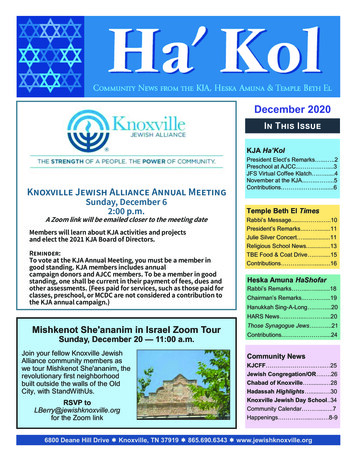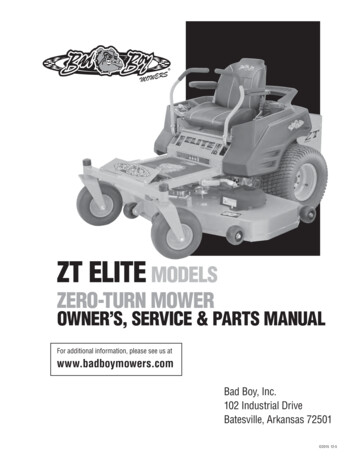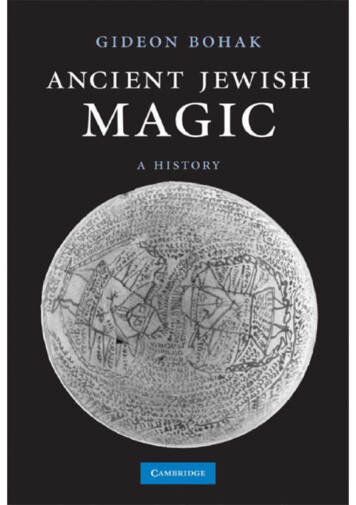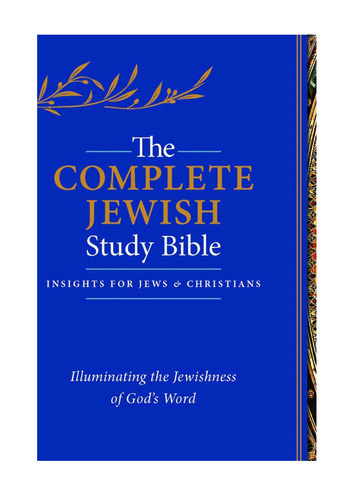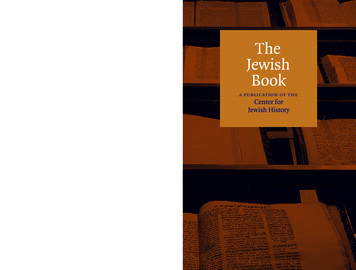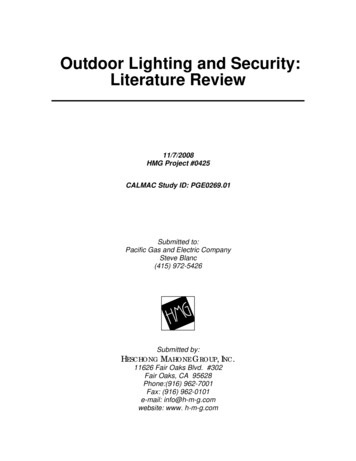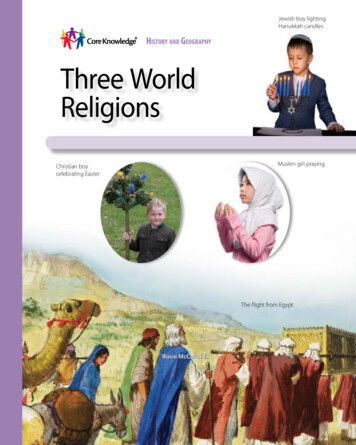
Transcription
Jewish boy lightingHanukkah candlesHistory and GeographyThree WorldReligionsMuslim girl prayingChristian boycelebrating EasterThe flight from EgyptRosie McCormick
THIS BOOK IS THE PROPERTY OF:STATEBook No.PROVINCEEnter informationin spacesto the left asinstructed.COUNTYPARISHSCHOOL DISTRICTOTHERISSUED TOYearUsedCONDITIONISSUEDRETURNEDPUPILS to whom this textbook is issued must not write on any page or markany part of it in any way, consumable textbooks excepted.1. T eachers should see that the pupil’s name is clearly written in ink in thespaces above in every book issued.2. The following terms should be used in recording the condition of the book:New; Good; Fair; Poor; Bad.
Three WorldReligionsRosie McCormick
Creative Commons LicensingThis work is licensed under aCreative Commons Attribution-NonCommercial-ShareAlike4.0 International License.You are free:to Share—to copy, distribute, and transmit the workto Remix—to adapt the workUnder the following conditions:Attribution—You must attribute the work in thefollowing manner:This work is based on an original work of the CoreKnowledge Foundation (www.coreknowledge.org) madeavailable through licensing under a Creative CommonsAttribution-NonCommercial-ShareAlike 4.0 InternationalLicense. This does not in any way imply that the CoreKnowledge Foundation endorses this work.Noncommercial—You may not use this work forcommercial purposes.Share Alike—If you alter, transform, or build upon this work,you may distribute the resulting work only under the same orsimilar license to this one.With the understanding that:For any reuse or distribution, you must make clear toothers the license terms of this work. The best way todo this is with a link to this web /4.0/All Rights Reserved.Core Knowledge , Core Knowledge Curriculum Series ,Core Knowledge History and Geography , and CKHG are trademarks of the Core Knowledge Foundation.Trademarks and trade names are shown in this bookstrictly for illustrative and educational purposes and arethe property of their respective owners. References hereinshould not be regarded as affecting the validity of saidtrademarks and trade names.ISBN: 978-1-68380-399-7Copyright 2019 Core Knowledge Foundationwww.coreknowledge.org
Three WorldReligionsTable of ContentsChapter 1What Is Religion? . . . . . . . . . . . . . . . . . . . . . . . . . . . . . . . . 2Chapter 2 The History of Judaism: Moses andthe Jewish People in Egypt . . . . . . . . . . . . . . . . . . . . 4Chapter 3The Flight from Egypt . . . . . . . . . . . . . . . . . . . . . . . . . . 11Chapter 4The History of Christianity . . . . . . . . . . . . . . . . . . . . . 16Chapter 5The History of Islam . . . . . . . . . . . . . . . . . . . . . . . . . . . . . 22
CHAPTER12What Is Religion?Religion is an important part of the lives of manypeople. Religion can show people how to live andbehave. For some people, religion explains how theworld was made. In this book, you will learn aboutthree of the many different religions that peoplepractice: Judaism, Christianity, and Islam.
Long ago, the people of ancient Egypt and Mesopotamiaworshipped many gods. Between three and four thousandyears ago, a small group of people—the Jewish people—livedin the lands between Egypt and Mesopotamia. We nowcall these lands part of the Middle East.The Jewish people had a new kind of religion. They believedin only one god. Today, the belief in one god is the mostimportant part of Judaism, Christianity, and Islam.3
CHAPTER2The History of Judaism: Moses andthe Jewish People in EgyptThe Torah, or holy book, tells the story of the Jewishpeople who had gone to live in Egypt. At first the Jewswere happy there. They grew stronger as a group. Butthen an Egyptian pharaoh saw how strong they werebecoming, and he did not like it. The pharaoh forced theJewish people to become slaves. They had to work in thehot desert, building Egyptian cities.4
Even though they were slaves, the Jews were not defeated.The pharaoh grew angry. He decided to kill all the Jewish babyboys by throwing them into the Nile River. One Jewish womandecided that the pharaoh would not kill her son. She made abasket and placed her baby inside. She sent the basket floatingdown the river. She told the baby’s sister, Miriam, to follow it.5
After a while, the basket became tangled in reeds thatgrew close to the riverbank. A lady who was sitting on theriverbank saw the baby and rescued him. Miriam hadfollowed her brother’s journey. Now she knew she had tobe brave. The lady who had rescued her brother was thepharaoh’s own daughter.6
“What a beautiful baby!” Miriam cried out, as she ran towardthe pharaoh’s daughter. “I know a Jewish slave woman whocould care for him.”The woman Miriamspoke of was thebaby’s real mother.The Egyptianprincess thoughtfor a moment, andthen she said, “I willraise this baby asmy own. His namewill be Moses, andhe will be a princeof Egypt! Bring methe slave woman.She can help me!”And so Moses’sreal mother wasallowed to care forhim when he wasa child.7
Moses grew up as a royal prince in Egypt. One day he saw anEgyptian hurting a Jewish slave. Though Moses grew up as anEgyptian prince, he knew that he was Jewish. Moses was soangry, he killed the Egyptian. Moses was forced to run away.He escaped to the desert and became a shepherd.8
Sometime later, Moses saw a very strange thing. He saw thata bush was on fire, and yet it was not burning up! As hemoved toward the bush, a voice spoke to him.“Moses,” the voice called, “I am the God of the Jews. Youmust lead them out of Egypt. Go back to the pharaoh andtell him to let my people go.”9
Even though Moses was afraid, he did as God asked. But thepharaoh would not let the Jewish people go free. To punishthe pharaoh and the Egyptians, God sent many terrible plaguesupon them. Still the pharaoh refused to free the Jews.10
CHAPTER3The Flight from EgyptFinally, Moses warned the pharaoh that God would killthe firstborn child in every Egyptian family if he did notfree the Jews. Once again the pharaoh refused.Then God told Moses to tell the Jewish people to marktheir doors withblood so that theAngel of Deathwould knowwhich homes topass over, or notenter. The Jewishpeople did this,and their firstborn childrenwere spared.When thepharaoh’s ownson was killedby the Angelof Death, thepharaoh finallylet the Jewishpeople go.11
Moses and the Jewish people escaped from Egypt. This is knownas the Exodus. The Jewish people had no time to get ready forthe journey. All they had to eat along the way was flat bread.12
The pharaoh changed his mind yet again. Just as the Jewishpeople reached Egypt’s border at the Red Sea, they saw hissoldiers chasing after them. Moses held up his staff, or stick,and God separated the Red Sea into two giant walls of water.Moses led the Jewish people across the dry path in the middle.As soon as the Jewish people were safe, the walls of water fellonto the pharaoh’s soldiers, and they were drowned.13
At last the Jewish peoplewere free to begin theirjourney to the land Godhad promised them, theland of Israel. Along theway, God spoke to Mosesand gave him the TenCommandments, the lawsthe Jewish people mustfollow. Sadly, Moses neverreached the land of Israel.14
Today, Jewish people practice their religion by praying, goingto a temple or synagogue, and reading or listening to storiesfrom the Torah, which is part of the Jewish Bible. The Star ofDavid is an important symbol of the Jewish faith.Important Jewish holidaysinclude Rosh Hashanah,or the Jewish New Year,Yom Kippur, or the Dayof Forgiveness, and Passover.During Rosh Hashanahpeople eat apples andhoney. Passover is thecelebration of freedom fromslavery in Egypt. DuringPassover, Jewish peopleeat flat bread and retellthe story of the Exodus.15
CHAPTER4The History of ChristianityChristians also believe in one god. For Christians, theirfaith is linked to the teachings of Jesus of Nazareth.The Christian Bible, or holy book, tells of Jesus’s life andhis teachings.Jesus was born about two thousand years ago inBethlehem, in Judaea, which was at the time part ofthe Roman Empire. Jesuswas Jewish. The Romansmade life difficult forthe Jews in Judaea.16
The story of Jesus’s birth tells of a man named Joseph and hiswife Mary, who were having a baby. Before the baby was born,Joseph and Mary traveled to Bethlehem. When they arrivedthere, the only place where they could stay was in a stable.17
It was there in the stable that Mary gave birth to Jesus.Shepherds and travelers known as wise men learned aboutthe birth of Jesus. They visited the baby Jesus in the stableand brought him gifts.18
When Jesus grew up, he traveled through the area known asGalilee. He was a teacher. Jesus said that people were equalin the eyes of God and they should treat each other withkindness. Crowds often gathered to hear him speak. Thosewho followed Jesus believed he was the messiah, or theperson they hoped would save them.19
The Romans arrested and killed Jesus. Before he was arrested,Jesus asked twelve men, his first followers, to eat a last Passovermeal with him. These followers are known as the TwelveDisciples. Today, Christians call this meal the Last Supper. AfterJesus died, his teachings were carried by his followers acrossthe Roman Empire.20
Today, Christians practice their faith by praying, going to church,and reading the Bible. There are many Christian holidays, orcelebrations, based on the life and teachings of Jesus. Duringthe Christmas season, Christians celebrate the birth of Jesus.During Easter, Christians remember the last days of Jesus’s lifeand his death on the cross. Christians believe that Jesus rosefrom the dead, and that is celebrated on Easter Sunday. Thecross is an important Christian symbol.21
CHAPTER522The History of IslamAbout six hundred years after Jesus lived, Muhammad,the prophet of Islam, was born in the city of Meccain Arabia. The religion that Muhammad established iscalled Islam. People who practice it are called Muslims,and their holy book is the Koran.
Muhammad was a merchant. He bought and sold things for aliving. Because of his work, he traveled and met many people.The story of Muhammad tells us that one day, while he was in acave, the angel Gabriel spoke to him. Muhammad left the caveand told his wife about the angel.23
Sometime later, the angel spoke to Muhammad again, andMuhammad began to tell others about the messages hereceived from the angel. The angel said that there was onlyone god. The Arabic word for God is Allah.Some people were angry with Muhammad because theyworshipped many gods. And so Muhammad, along with hisfollowers, left Mecca and escaped to a city called Medina.24
In Medina people began following the teachings ofMuhammad. Through these teachings they came to believe inone god. Then in 630 CE, Muhammad returned to Mecca withmany of his followers. They destroyed the statues of gods thepeople there worshipped. Muhammad died two years afterhis return to Mecca. His followers carried his teachings acrossthe Middle East and beyond.25
Today, Muslims practice their faith by reading the Koran andpraying. Sometimes they go to a mosque, or place of worship.The month of Ramadan is holy for Muslims, because during thatmonth they remember the words Muhammad received from theangel. At the end of Ramadan, Muslims enjoy a special feast calledEid al-Fitr. The star and crescent are important symbols of Islam.26
CK HG Core Knowledge History and Geography Series Editor-in-ChiefE. D. Hirsch Jr.Editorial DirectorsLinda Bevilacqua and Rosie McCormick
Subject Matter ExpertSpencer Leonard, PhDIllustration and Photo CreditsASAP / Alamy Stock Photo: 15dCrossing the Red Sea (gouache on paper) / Private Collection / Look and Learn / Bridgeman Images: 13Design Pics Inc / Alamy Stock Photo: 15aFrans lemmens / Alamy Stock Photo: 21bHyderabad / Alamy Stock Photo: 26cimageBROKER / Alamy Stock Photo: Cover BIsraelites making bricks iin Egypt. Exodus I. II:14 - Bible, Hole, William Brassey (1846-1917) / Lebrecht History / Bridgeman Images: 4Jesus and the twelve apostles - Bible, Hole, William Brassey (1846-1917) / Lebrecht History / Bridgeman Images: 19Joseph and Mary arrive at Bethlehem, but find there is no room for them at the inn, Hole, William Brassey (1846-1917) / Private Collection / Look and Learn /Bridgeman Images: 17Leo Lintang / Alamy Stock Photo: Cover CMartin Eichler / Mauritius / SuperStock: 21cMartin Siepmann / Westend61 / SuperStock: 26bMoses and Aaron before Pharaoh, English School, (20th century) / Private Collection / Look and Learn / Bridgeman Images: 10Moses descending from Mount Sinai, English School, (19th century) / Private Collection / Look and Learn / Bridgeman Images: 14Moses in the Wilderness, Uptton, Clive (1911-2006) / Private Collection / Look and Learn / Bridgeman Images: Cover D, 12Moses is found by a princess - Bible / Lebrecht History / Bridgeman Images: 6Moses left among the flags, English School, (20th century) / Private Collection / Look and Learn / Bridgeman Images: 5Moses, English School, (20th century) / Private Collection / Look and Learn / Bridgeman Images: 9Oppression, English School, (20th century) / Private Collection / Look and Learn / Bridgeman Images: 8PhotoAlto / SuperStock: 21aReading the Torah in front of a stained glass window depicting the Star of David and the Ten Commandments (photo) / Godong/UIG / Bridgeman Images: 15bRoman Yanushevsky / Alamy Stock Photo: Cover ASchematic View of Mecca, showing the Qua’bah, from a book on Persian ceramics (print), Persian School / Private Collection / The Stapleton Collection /Bridgeman Images: 22Steve Hamblin / age fotostock / SuperStock: 26dTetra Images / SuperStock: 21dThe Archangel Gabriel inspiring Mohammed in the mosque of medina (gouache on paper), Ottoman School, (18th century) / Museum of Turkish and Islamic Art,Istanbul, Turkey / Photo AISA / Bridgeman Images: 23The Flight of Muhammad to Medina, illustration from ‘The Outline of History’ by H.G. Wells, Volume II, published in 1920 (colour litho), Michael, Arthur C. (d.1945)(after) / Private Collection / Photo Ken Welsh / Bridgeman Images: i, iii, 24The Last Supper, Carducho, Bartolomé (1560-1608) / Prado, Madrid, Spain / Bridgeman Images: 20The Mother of Moses, c.1860 (oil on canvas), Solomon, Simeon (1840-1905) / Delaware Art Museum, Wilmington, USA / Bequest of Robert Louis Isaacson /Bridgeman Images: 7The Picture Pantry / The Picture Pantry / SuperStock: 15cThe Plagues of Egypt. Tenth plague: death of firstborn. Engraving by Dore. coloured., Dore, Gustave (1832-83) / Private Collection / Tarker / Bridgeman Images: 11The shepherds finding the infant Christ lying in a manger, Hole, William Brassey (1846-1917) / Private Collection / Look and Learn / Bridgeman Images: 18The taking of Jerusalem by the Romans under the direction of Titus, Scarpelli, Tancredi (1866-1937) / Private Collection / Look and Learn / Bridgeman Images: 16View of Mecca. Illustration from La Vie de Mohammed, Prophete d’Allah (The Life of Mohammed, Prophet of Allah). / Universal History Archive/UIG /Bridgeman Images: 25Werli Francois / Alamy Stock Photo: 26a
CK HG Core Knowledge History and GeographyA comprehensive program in world and American historyand geography, integrating topics in civics and the arts,exploring civilizations, cultures, and concepts specified in theCore Knowledge Sequence (content and skill guidelines for Grades K–8)Core Knowledge History and Geography units at this level include:Continents, Countries, and MapsMesopotamiaAncient EgyptThree World ReligionsEarly Civilizations of the AmericasThe Culture of MexicoEarly Explorers and SettlersFrom Colonies to IndependenceExploring the Westwww.coreknowledge.orgISBN: 978-1-68380-399-7Core Knowledge Curriculum Series Series Editor-in-ChiefE. D. Hirsch Jr.
The Torah, or holy book, tells the story of the Jewish . people who had gone to live in Egypt. At first the Jews were happy there. They grew stronger as a group. But then an Egyptian pharaoh saw how strong they were becoming, and he did not like it. The pharaoh forced the Jewish people to become slaves. They had to work in the
